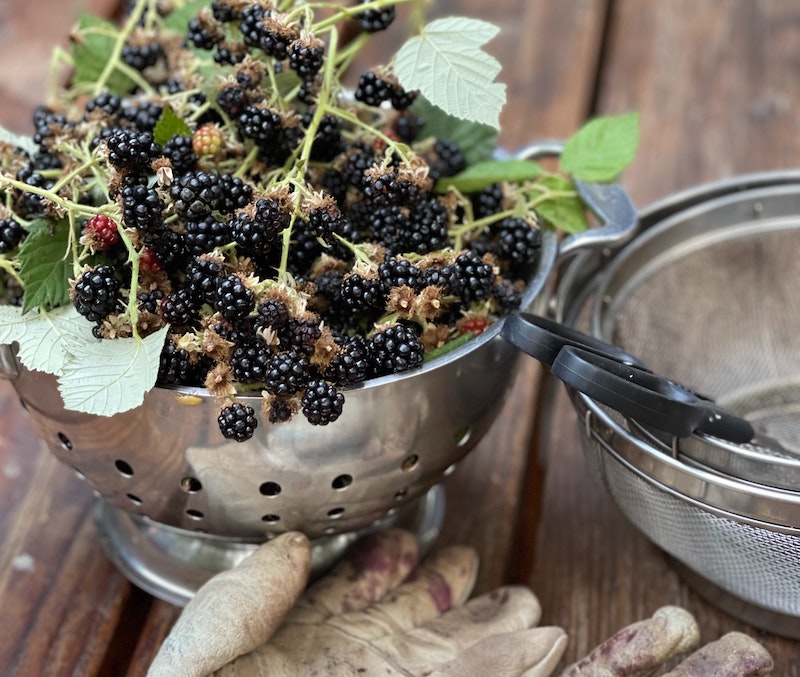Moneywise home gardeners may opt to incorporate blackberries, or brambles, into the home garden for good reason. Their market cost reflects how highly perishable they are, so having a ready supply available is convenient and not particularly difficult. Blackberries, like raspberries, are members of the genus Rubus, and are fairly easy to cultivate. They require only basic care and proper siting to produce sizable yields.
Blackberries are classified by their growth habit, whether or not they have thorns, and whether they are everbearing or double cropping. Growth habits may be trailing, semi-trailing, or erect, but all benefit from some sort of support. It is also possible to categorize these plants by the time in the season the fruits ripen.

Caring For Blackberry Bushes
Blackberries require full sunlight and plenty of room between plants to thrive. These plants have perennial roots but the shoots are biennials, meaning that the first-year canes grow only vegetatively and then in the second year, canes start to produce fruit. The most important considerations when deciding to grow blackberries include choosing a good site with plenty of room for plants to grow and receive support. Regular water, especially during fruiting, is also important.
Planting Blackberry Bushes
Prior to planting, it is a good idea to thoroughly plan and prepare the site. This might involve removing any weeds, incorporating organic matter into the soil, making a raised bed, or constructing a trellis or other support. Choose a site with full sunlight; these plants survive in partial shade but will produce less fruit. The ideal position would also offer some protection from harsh winds.
Blackberries prefer well-drained, sandy loam soil; in sites with a high clay or sand content, work ample organic matter into the soil prior to planting. The pH range for blackberry cultivation is 5.6 to 6.5, so if a soil test reveals a pH outside of this range, incorporate an acidic or alkaline amendment into the site soil. Plant blackberries with a trailing habit 6 to 8 feet apart. Erect and semi-trailing types only need 3 or 4 feet of space.

Watering Blackberry Bushes
Established blackberry plants will survive extended periods of drought, but need regular moisture to thrive and produce a high yield of good fruit. During the growing season, make sure the blackberries receive at least an inch to an inch and a half of water through rainfall and supplemental irrigation. With each watering, wet the top foot of soil. The goal with watering is to avoid letting the soil dry out completely in the root zone between watering cycles.
During fruit development, watering is particularly critical. At this time, each plant may accept up to two gallons of water daily. Maintaining a 3-inch layer of organic matter over the blackberry root zone without covering the crown will help to conserve soil moisture while also suppressing weeds.
Fertilizing Blackberry Bushes
Working compost or other organic matter into the site at planting will eliminate the need for fertilizer immediately following planting. Otherwise, sprinkle a slow-release, complete fertilizer like a 10-10-10 or 16-16-16 formula at a rate of about 1 ounce of nitrogen per plant once new growth appears. In subsequent years, apply fertilizer in two or more separate applications each year, depending on plant requirements in the specific site.
The first annual application at a rate of about 3 to 4 ounces of nitrogen per plant should occur early in the growing season, before the plant begins to produce flowers and fruits. Another fertilizer application of the same size can occur following harvest.
Growing Blackberry Bushes In Pots
While blackberries are traditionally grown in the ground because of their relatively large space requirements, it is possible to keep them in sufficiently large pots. Some cultivars have been bred to stay compact, so look for these types. Any container must have plenty of drainage holes. A pot with a 20 to 30 gallon capacity will hold a mature blackberry plant. Use a high-quality potting soil or mixture of potting soil and well-rotted compost.
Container-grown plants will be more prone to drying out than their in-ground counterparts, so plan to check on them and irrigate more frequently.

Harvesting Blackberry Bushes
Since the shoots of blackberry plants are biennials, do not expect fruits to develop until the second year. Fruit is ready to harvest over a period of three or more weeks, with the timing and duration varying by berry variety. Fruits are at peak sweetness when they are a dull black. They can be picked when shiny and stored in the refrigerator, but will not be as sweet as when picked at peak ripeness.
For floricane (not primocane or everbearing) types, cut back all of the old fruiting canes to ground level in late fall and remove them from the garden. Just after harvest is a good time to perform a second application of a balanced fertilizer unless fall is approaching.
 |
Author Angela Ryczkowski - Published 3-14-2023 |
